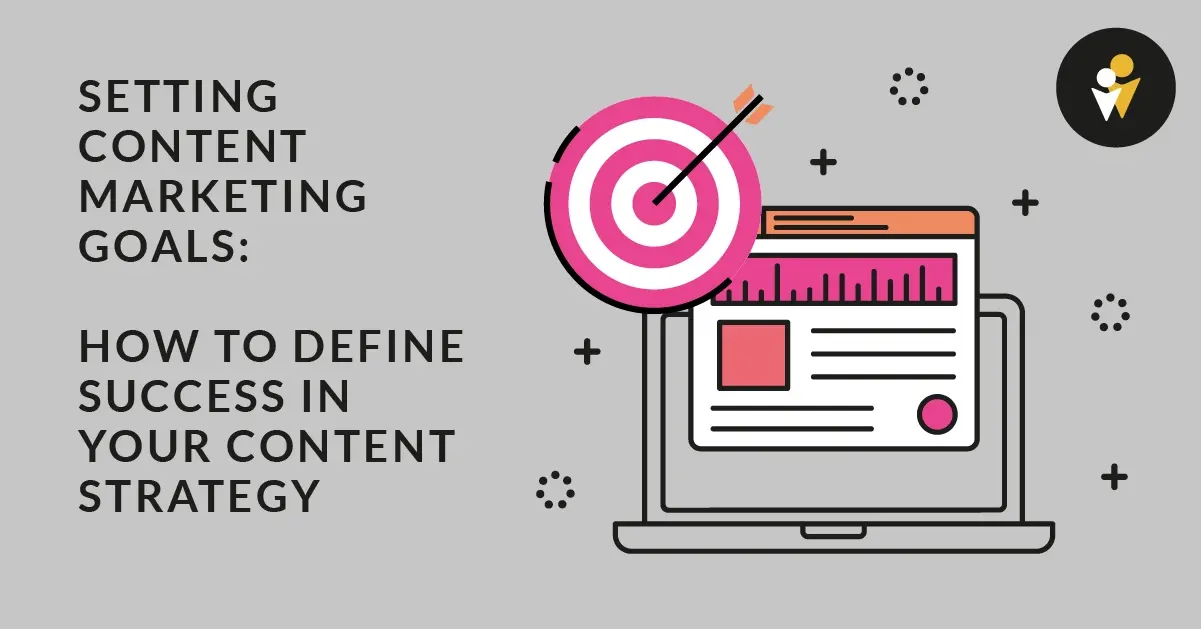Did it work?
This is the first question we ask when studying the results of marketing efforts. Setting content marketing goals that align with your business objectives is critical to actually achieving success. To define success in your content strategy, you can look at the popular analytics, but there are a few, far more subtle indications for content strategy success in places you might not think to look.
Defining “success” is essential for understanding the future impact of your efforts and aligning them with business goals. Whether you're aiming to increase brand awareness, generate leads, or establish industry authority, knowing how to properly set content strategy goals can help refine future strategies and maximize ROI.

Defining Success in Your Content Marketing Strategy
Determining if your content strategy was effective is nearly the last thing you do before tweaking the process and trying it again. Defining success, however, happens before you develop the strategy. You must know what lies in your path before you choose your vehicle, because you can’t cross a river in a car. You can’t demonstrate authority in your industry without providing quality information people are looking for. If the journey your customer must take is a road, your content is the bus they ride to their desired destination.
3 Steps to Setting Content Marketing Goals That Align with Business Objectives
Marketing drives the success of a business. Getting to the root of how your marketing department supports overall business objectives is one place to find measures for success. Your entire marketing strategy should be built with the overall business goals in mind. Does having a million Instagram followers support the goals of your business? Maybe it does, and maybe it does indirectly, but it’s up to you to make those connections.
 Step 1 to Content Strategy Success: Understand Your Client’s Mission
Step 1 to Content Strategy Success: Understand Your Client’s Mission
For Your Clients: Knowing what your ideal customer is working to accomplish is a primary driver of the content you produce.
Let’s imagine there are three people who want the service your business provides, but their missions—what each one needs to accomplish—differ greatly. Given that, it is likely that not all of them will be your ideal client:
An Example of Planning Your Content Strategy Goals
Marcus, Sophie, and Chaitali are three heroes looking to contract a marketing agency. Though they share the same goals, they have different needs based on their desired outcome.
Marcus needs promotion to begin as soon as possible for his grand opening in two months. Sophie added a new offering to her product line and needs a cost-effective solution to spread the word. Chaitali is the curator for a new high-end art gallery in a historical building and will spare no expense in obtaining a professional agency with experience in promoting high-ticket products.
Based on their individual desired outcomes, their choice of a marketing agency might be different. Marcus might pay more for the rush job from the one company that will accommodate his timeline. Sophie might hire a friend to run her social media on a budget as a favor. Chaitali will seek the agency best able to provide the specialized marketing treatment her gallery requires.
Having a clear view of each prospect’s end game will help you build a marketing content strategy that effectively targets the prospect(s) that best match your ideal customer profile (AKA, your Hero).
For Your Strategy: Effective marketing can move the dial on a business’s bottom line. A single campaign can turn the tide for a floundering business. Consider how your company, as a whole, defines success and explore how marketing can drive action to accomplish the goal.
- Sign 10 new clients per month = Continually boost brand awareness across platforms your Heroes use to reach a wider target audience (add link to new post - /identifying-your-target-audience)
- Goal: Raise overall impressions across website and social media platforms
Measures: Baseline + 20% increase in impressions - Goal: Develop a highly desired offering as a lead generation tool
Measures: Conversion rates of Leads: MQL (marketing qualified leads); SQL (sales qualified leads); Closed-Won deals
- Goal: Raise overall impressions across website and social media platforms
- Be the authority and thought leader of the industry = Develop high quality content accompanied by enhanced SEO to establish your business as a trusted subject matter expert.
- Goal: Consistently post informative articles about industry products and services to help navigate barriers in choosing your business.
Measures: Review overall Search and general analytics compared to your baseline
- Goal: Consistently post informative articles about industry products and services to help navigate barriers in choosing your business.
TIP: Use SMART goals as a format for defining success for your content strategy. For a team of creators, the BORRAT framework (Background, Objectives, Requirements, Resources, Approach, Time) offers a comprehensive method for aligning teams to achieve a specific outcome. The BORRAT ensures everyone, from writers to designers and SEO specialists, remains aligned with the mission.
Step 2: Establish Baseline Data Points
This is the easy part.
Collect data on your current performance to understand where you’re starting. This might include:
- Website Traffic: Track unique visitors, page views, and bounce rates.
- Engagement Metrics: Measure social shares, comments, and likes.
- Conversion Rates: Analyze how many visitors convert into leads or customers.
Use historical data to set realistic benchmarks. For example, calculate the average monthly website traffic from the past year and use it as a reference point for future growth. growth.
 Step 3: Consider the Qualitative
Step 3: Consider the Qualitative
You have set your new content strategy in place and wait for the impressions, clicks, reads, reactions, and engagements to come through. You check back with the sales team to see if they are working hard or hardly working. Aside from those tangible, quantitative KPIs, consider other indications your content strategy is working.
What constitutes “good?” Do people like it? How do you know? You ask. At the end of an article or blog post, consider allowing your readers to rate the helpfulness of your content. If your sales team is using the content to support their sales effort, then you know the information is valuable.
Putting it all Together
- Your first step of marrying your content strategy goals to business objectives is almost as important as understanding the desired outcomes of your Hero.
- You must know where you are starting to measure how far your new strategy takes you. So, be sure to establish benchmarks.
- Think outside the box when it comes to qualitative measures. Average engagement time can inform you if users are reading the entire article or stopping halfway through. Requesting reader feedback and quality ratings will tell you if they are finding the answers they’re seeking.
Frequently Asked Questions
An example of a content marketing goal could be:
- Increase Website Traffic by 20% in 6 Months: This goal focuses on driving more visitors to your website through content marketing efforts. You might achieve this by consistently publishing SEO-optimized blog posts, engaging social media content and targeted email campaigns. The success of this goal can be measured by tracking website analytics, such as unique visitors, page views, and bounce rates.
- Tactical Goals: Short-term, specific actions aimed at driving immediate results, like increasing website traffic or generating leads.
- Strategic Goals: Long-term objectives that build brand authority and foster trust over time, such as becoming a thought leader in your industry.
Need Help Setting Content Marketing Goals?
Establishing goals for your new content strategy should feel like an exciting new frontier. Change can be risky, but sticking with the same old, same old is likely even riskier. Continuous improvement is key to success; defining that success places a pin on your desired destination.
Need help finding True North on your Hero’s Journey through a new content strategy? PIC’s unique Hero Mission Strategy® will show you the way. Contact Us today to help you establish what success means to you, your business, and your content strategy.













